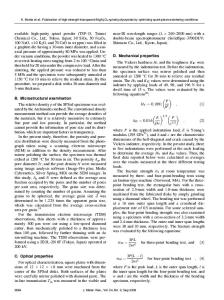Synthesis of MgAl 2 O 4 spinel nanoparticles via polymer-gel and isolation-medium-assisted calcination
- PDF / 507,271 Bytes
- 7 Pages / 584.957 x 782.986 pts Page_size
- 86 Downloads / 374 Views
Yuting Cuib) Physics Department, Chongqing Normal University, Chongqing 404100, China (Received 1 July 2014; accepted 8 October 2014)
Magnesium aluminate (MgAl2O4) spinel nanoparticles with an average crystalline size of 35 nm were synthesized by polymer-gel and isolation-medium-assisted calcination. In the process, a large excess of MgO, 40 times the stoichiometric amount of spinel, is added to the precursor mixture to separate the spinel particles as they are nucleated to prevent their agglomeration and coarsening during calcination. Well-dispersed MgAl2O4 nanoparticles with a single-crystal structure were obtained after acid washing of calcined product. The microstructures of the as-prepared samples were characterized by differential thermal and thermogravimetric analysis, x-ray diffractometry, Fourier transform infrared spectroscopy, nitrogen adsorption–desorption isotherms, scanning electron microscopy, energy-dispersive x-ray spectroscopy, and transmission electron microscopy. The results indicate that MgO acting as the isolation medium is effective in preventing the agglomeration of MgAl2O4 nanoparticles, and it also prevents their contamination by introducing an isolation medium during the preparation process. The nanopowder was sintered up to 95% of the theoretical density but with parallel grain growth.
I. INTRODUCTION
Magnesium aluminum (MgAl2O4) spinel is considered to be an important ceramic material, and it possesses attractive features such as high mechanical strength, good chemical stability, high thermal shock resistance, and low electrical losses.1–3 It also has apparent optical properties, which are similar to those of glass, and it has been applied in lighting and laser technologies.4–6 MgAl 2 O4 spinel ceramic is one of the main materials used in military and space applications because of its simple synthesis, excellent mechanical properties, and transparency over a wide range of 0.2–6 lm.7–9 The potential applications of MgAl2O4 spinel ceramic materials are therefore vast. Ceramic powder preparation is fundamental in the synthesis and application of ceramic materials. MgAl2O4 nanoparticles with a narrow size distribution and a low degree of agglomeration are desirable in these applications. Various approaches have been used to synthesize disperse MgAl2O4 spinel nanoparticles, such as solid-state reaction, co-precipitation, and sol–gel syntheses.10–13 Among these, the solid-state reaction route is suitable for producing nanoparticles on a large-scale, but it usually results in particle coarsening because of high reaction Address all correspondence to these authors. a) e-mail: [email protected] b) e-mail: [email protected] DOI: 10.1557/jmr.2014.341 J. Mater. Res., Vol. 29, No. 24, Dec 28, 2014
http://journals.cambridge.org
Downloaded: 13 Mar 2015
temperature used. The co-precipitation route is simple, economical, and suitable for industrial production, but the as-prepared particles are agglomerated sometimes. Ultrafine particles can be obtained by the sol–gel route, but partial sintering oc
Data Loading...










